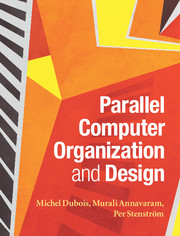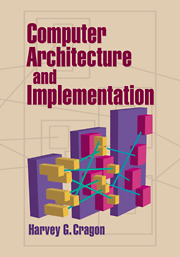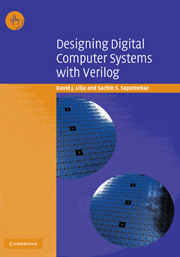Parallel Computer Organization and Design
Teaching fundamental design concepts and the challenges of emerging technology, this textbook prepares students for a career designing the computer systems of the future. In-depth coverage of complexity, power, reliability and performance, coupled with treatment of parallelism at all levels, including ILP and TLP, provides the state-of-the-art training that students need. The whole gamut of parallel architecture design options is explained, from core microarchitecture to chip multiprocessors to large-scale multiprocessor systems. All the chapters are self-contained, yet concise enough that the material can be taught in a single semester, making it perfect for use in senior undergraduate and graduate computer architecture courses. The book is also teeming with practical examples to aid the learning process, showing concrete applications of definitions. With simple models and codes used throughout, all material is made open to a broad range of computer engineering/science students with only a basic knowledge of hardware and software.
- In-depth coverage of key design issues: complexity, power and reliability, as well as performance
- Covers core microarchitecture, chip multiprocessors and large-scale multiprocessor systems
- Contains many examples and end-of-chapter problems, with a solutions manual and lecture slides available online
Reviews & endorsements
"Parallel computers and multicore architectures are rapidly gaining importance because the performance of a single core is not improving at the same historical level. Professors Dubois, Annavaram, and Stenstrom have created an easily readable book on the intricacies of parallel architecture design that academicians and practitioners alike will find extremely useful." - Shubu Mukherjee, Cavium, Inc.
"The book can help the readers to understand the principles of parallel systems crystally clear. A necessary book to read for the designers of parallel systems." - Yunji Chen, Institute of Computing Technology, Chinese Academy of Sciences
"All future electronic systems will comprise of a built-in microprocessor, consequently the importance of Computer Architecture will surge. This book provides an excellent tutorial of Computer Architecture fundamentals from the basic technology via processor and memory architecture to chip multiprocessors. I found the book very educationally flow and readable – an excellent instructive book worth using." - Uri Weiser, Technion
"This book really fulfils the need to understand the basic technological on-chip features and constraints in connection with their impact on computer architecture design choices. All computing systems students and developers should first master these single and multi core foundations in a platform independent way, as this comprehensive text does." - Mateo Valero, BSC
"After the drastic shift towards multi-cores that processor architecture has experienced in the past few years, the domain was in dire need of a comprehensive and up-to-date book on the topic. Michel, Murali and Per have crafted an excellent textbook which can serve both as an introduction to multi-core and parallel architectures, as well as a reference for engineers and researchers." - Olivier Temam, INRIA, France
"Parallel Computer Organization and Design" fills an urgent need for a comprehensive and authoritative yet approachable tutorial and reference text for advanced computer architecture topics. All of the key principles and concepts covered in Wisconsin's three-course computer architecture sequence are addressed in a well-organized, thoughtful, and pedagogically appealing manner, without overwhelming the reader with distracting trivia or an excess of quantitative data. In particular, the coverage of chip multiprocessors in Chapter 8 is fully up to date with the state of the art in industry practice, while the final chapter on quantitative evaluation--a true gem!--is a unique and valuable asset that will clearly set this book apart from its competition." - Mikko Lipasti, University of Wisonsin-Madison
"The book contains in-depth coverage of all the aspects of the computer systems. It is comprehensive, systematic, and in sync with the latest development in the field. The skillfully organized book uses self-contained chapters to allow the readers get a complete understanding of a topic without wandering through the whole book. Its content is rich, coherent and clear. Its questions are crafted to stimulate creative thinking. I recommend the book as a must read to all graduate students and young researchers and engineers designing the computers." - Lixin Zhang, Institute of Computing Technology, Chinese Academy of Sciences
"… parallel architectures are the key for high performance and high efficiency computing systems. This book tells the story of parallel architecture at all levels – from the single transistor to the full blown CMP – an unforgettable journey!" - Ronny Ronen, Intel
"Multicore chips have made parallel architectures ubiquitous and their understanding a necessity. This text provides a comprehensive treatment of parallel system architecture and the fundamentals of cache coherence and memory consistency in the most compact form to date. This is a perfect text for a one semester graduate course." - Lawrence Rauchwerger, Texas A&M University
"It is the best of today's books on the subject, and I plan to use it in my class. It is an up-to-date picture of parallel computing that is written in a style that is clear and accessible." - Trevor Mudge, Bredt Family Professor of Computer Engineering, The University of Michigan
"Parallelism, at multiple levels and in many different forms, is now a necessity for all future computer systems, and the new generation of computer scientists and engineers have to master it. To understand the complex interactions among the hundreds of existing ideas, options, and choices, one has to categorize them, put them in order, and then synthesize them. That is precisely what Dubois, Annavaram, and Stenström do, in a magnificent way, in this extremely contemporary and timely book. I want to particularly stress the uniquely clear way in which the authors explain the hardest among these topics: coherence, synchronization, and memory consistency." - Manolis Katevenis, Head of the Computer Architecture and VLSI Systems Laboratory, FORTH-ICS; and Professor of Computer Science, University of Crete, Heraklion, Greece
"This book is a truly comprehensive treatment of parallel computers, from some of the top experts in the field. Well grounded in technology yet remaining very accessible, it also includes important but often overlooked topics such reliability, power, and simulation." - Norm Jouppi, HP
"This text takes a fresh cut at traditional computer architecture topics and considers basic principles from the perspective of multi-core and parallel systems. The need for such a high quality textbook written from this perspective is overdue, and the authors of this text have done a good job in organizing and revamping topics to provide the next generation of computer architects with the basic principles they will need to design multi-core and many-core systems." - David Kaeli, Director of the NU Computer Architecture Research Laboratory, NEU
"An excellent book in an area that has long cried out for tutorial material --- it will be an indispensable resource to students and educators in parallel computer architecture." - Josep Torrellas, University of Illinois
Product details
May 2013Adobe eBook Reader
9781139557894
0 pages
0kg
206 b/w illus. 49 tables 95 exercises
This ISBN is for an eBook version which is distributed on our behalf by a third party.
Table of Contents
- 1. Introduction
- 2. Impact of technology
- 3. Processor microarchitecture
- 4. Memory hierarchies
- 5. Multiprocessor systems
- 6. Interconnection networks
- 7. Coherence, synchronization, and memory consistency
- 8. Chip multiprocessors
- 9. Quantitative evaluations.






